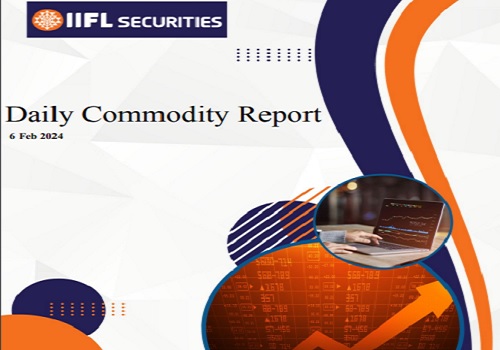A Daily Report on Bullion Energy & Base Metals for 6 February 2024 - IIFL Securities Ltd

Gold
Commentary
Gold faced a decline of -0.39% yesterday, settling at 62,316, driven by robust U.S. jobs data and statements from Federal Reserve Chair Jerome Powell that tempered expectations for early rate cuts. Powell emphasized the need for prudence in deciding when to cut the benchmark interest rate, citing a strong economy that provides time for central bankers to build confidence in further inflation declines. The dollar index reached an eight-week high, and yields on 10-year Treasury notes surged to over 4%, propelled by a better-than-expected U.S. Labor Department report revealing a significant increase of 353,000 jobs in January, nearly double the forecast of 180,000. Traders now see a 60% chance of a U.S. rate cut in May, according to the CME Fed Watch Tool. Investor focus is now directed towards statements from various Fed speakers this week for additional insights into potential rate cuts. In India, slow physical gold buying was observed as jewellers awaited a possible import duty reduction, and retail consumers hesitated due to higher prices. Conversely, China experienced robust demand for the festive period. Dealers offered discounts of up to $4 an ounce over official domestic prices, reflecting a narrowing from last week's discounts of up to $9. Technically, the gold market is witnessing long liquidation, with a -1.47% drop in open interest, settling at 14,182. Gold is currently finding support at 62,105, and a breach below this level could lead to a test of 61,890. On the upside, resistance is anticipated at 62,530, and a move above could see prices testing 62,740.
* Gold trading range for the day is 61890-62740.
* Gold prices slipped after a robust U.S. jobs data
* U.S. non-farm payrolls in January rose more than expected
* Traders price in 60% chance of rate cut in May
* Investors await remarks from Fed speakers this week

Silver
Commentary
Silver faced a decline of -1.02%, settling at 70480, primarily driven by robust United States Nonfarm Payrolls (NFP) data for January. Investors now anticipate the Federal Reserve (Fed) maintaining interest rates in the 5.25%-5.50% range during March's monetary policy meeting, as the strong labor market data supports the case for sustained higher interest rates until the end of spring. The data reflects a positive demand outlook with strong labor demand and higher wage offerings by U.S. employers. The United States Bureau of Labor Statistics (BLS) reported a significant increase of 353K payrolls in January, nearly doubling the consensus of 180K and surpassing the revised December figures of 333K. Average Hourly Earnings exceeded expectations, growing by 0.6%, and the annual wage growth stood at 4.5%, higher than the estimated 4.1%. Fed Governor Michelle Bowman highlighted the encouraging decline in price pressures but cautioned against premature rate cuts. She emphasized that early rate cuts could hinder the decline in price pressures toward the 2% target, potentially necessitating future interest rate hikes. Technically, Silver witnessed fresh selling with a 9.68% increase in open interest, settling at 32261. The market is currently supported at 70200, with a potential test of 69925. Resistance is expected at 70890, and a breakthrough could lead to a test of 71305. The technical indicators suggest a cautious approach, considering the impact of economic data and Fed policies on silver's price dynamics in the current market scenario.
* Silver trading range for the day is 69925-71305.
* Silver price dropped as investors see Fed rate cut after spring.
* Robust demand for workers has tampered Fed rate-cut bets.
* The outlook for the US dollar and bond yields has improved significantly.
* Fed’s Bowman said that the recent decline in price pressures is encouraging but cautioned about early rate cuts

Crude Oil
Commentary
Crude oil experienced a 0.85% uptick yesterday, settling at 6081, primarily driven by concerns over potential trade and supply disruptions in the Middle East. Tensions in the region escalated as the U.S. announced plans for further military action against Iran-backed groups, heightening geopolitical uncertainties. The fear of supply disruptions, coupled with fading expectations of immediate interest rate cuts by the U.S. Federal Reserve and lingering worries about China's economic recovery, weighed on the global demand outlook. Azerbaijan's energy ministry reported an expected decrease in oil production for the year, projecting 29.5 million metric tons compared to last year's 30.2 million tons. In the U.S., crude inventories rose by 1.2 million barrels to 420.7 million barrels in the week ending January 26, contrary to expectations for a 217,000-barrel draw. However, stocks at the Cushing, Oklahoma, delivery hub fell by 2 million barrels during the same period. Money managers increased their net long positions in U.S. crude futures and options, according to the U.S. Commodity Futures Trading Commission (CFTC). The speculator group raised its combined futures and options position in New York and London by 18,082 contracts to 117,226 during the week ending January 30. From a technical standpoint, the market is currently experiencing short-covering, with a -3.29% drop in open interest, settling at 13,170. Crude oil is finding support at 5993, and a breach below this level could lead to a test of 5904. On the upside, resistance is anticipated at 6130, and a move above could propel prices towards 6178.
* Crudeoil trading range for the day is 5904-6178.
* Crude oil gains on concerns about potential trade and supply disruptions amid tensions in the Middle East.
* US crude stocks rose last week as refineries recovered from freezing weather.
* Azerbaijan's 2024 oil production seen at 29.5 mln T
* Money managers raised their net long US crude futures and options positions.

Natural Gas
Commentary
Natural gas settled down by -0.4% at 173.2, influenced by reduced demand forecasts for the next two weeks and increasing output levels. The market was weighed down by expectations of above-average temperatures until at least February 15, with a return to normal anticipated on February 16-17. The prospect of colder weather later in the month is expected to boost heating demand. However, rising gas production, as wells resume operations after the mid-January Arctic freeze, contributed to the downward pressure on prices. Technical analysis reveals that the market is under fresh selling pressure, with a 1.09% increase in open interest, settling at 67011. Natural gas is currently finding support at 171, and a breach could lead to a test of 168.8. Resistance is anticipated at 175.7, with a move above potentially testing 178.2. The limited gas flow to the nation's LNG export facilities due to technical issues at Freeport LNG's export plant in Texas also played a role in the market dynamics. Gas output in the U.S. Lower 48 states increased to an average of 105.4 billion cubic feet per day in February from 102.0 bcfd in January, although still below the monthly record high of 106.3 bcfd in December. Meteorological projections suggest that temperatures in the Lower 48 states will remain warmer than normal through at least February 15 before turning near normal on February 16-17. While colder temperatures in mid-February may boost heating demand, current expectations indicate ongoing wa
* Naturalgas trading range for the day is 168.8-178.2.
* Natural gas prices fell due to lower demand forecasts and increased output levels
* Gas output in the U.S. Lower 48 states rose to an average of 105.4 bcfd in February
* Gas production is increasing as more wells resume operations after the mid-January Arctic freeze
* Meteorologists project temperatures in the Lower 48 states to remain warmer than normal through at least February 15


Copper
Commentary
Copper faced a decline of -0.84% yesterday, settling at 715.95, driven by concerns over demand in China, uneven global industrial activity, and expectations of prolonged higher U.S. interest rates. Persistent worries about China's real estate sector and uncertainties regarding the trajectory of Federal Reserve policies contributed to the negative sentiment surrounding copper. The apprehension about demand was evident in the copper inventories in warehouses monitored by the Shanghai Futures Exchange, which surged by 36%, reaching their highest level since July. LME cash copper's discount to the three-month contract also hit a record high of $109, indicating weak demand dynamics. Despite some support from declining copper stocks in LME-registered warehouses to their lowest level since September, overall sentiment remained bearish. In Chile, the world's largest copper producer, output remained unchanged year-on-year in December at 495,537 metric tons, as reported by the country's INE statistics agency. However, manufacturing production in Chile saw a 1.8% decrease during the same period, according to INE. China's Nonferrous Metals Industry Association (CNIA) advised copper smelters to cut production and postpone new projects due to tightening raw material supplies, following the closure of a major copper mine in Panama. Technically, the copper market is witnessing fresh selling momentum, with a 6.44% increase in open interest, settling at 5,207. Copper is currently finding support at 713.2, and a breach below this level could lead to a test of 710.4. On the upside, resistance is expected at 720.7, with a move above potentially testing 725.4.
* Copper trading range for the day is 710.4-725.4.
* Copper fell on concerns about demand China, patchy global industrial activity
* Copper inventories in Shanghai Futures Exchange warehouses are up 36%
* Ongoing worries about China's real estate sector and Fed policy are impacting demand

Zinc
Commentary
Zinc experienced a decline of -0.94%, settling at 217, influenced by a notable increase of 23.10% in inventories in warehouses monitored by the Shanghai Futures Exchange. The market faced additional pressure from data indicating a contraction in manufacturing activity in China and a stronger dollar. U.S. Federal Reserve Chair Jerome Powell's announcement ruling out a rate cut at the March meeting dampened market expectations that had hoped for such a move. Global manufacturing performance at the beginning of 2024 presented a mixed picture, with new orders driving momentum in the United States. However, soft Chinese demand left Asia's economies on shaky ground, and disruptions to Red Sea shipping delayed deliveries in Europe. Swedish miner Boliden's plans to shrink operations and reduce targeted output at its Tara zinc mine in Ireland also contributed to market sentiment. The mine, among the largest globally, was put on care and maintenance in June due to low zinc prices. The International Lead and Zinc Study Group (ILZSG) reported an increase in the global zinc market deficit to 71,600 metric tons in November 2023 from 62,500 tons in October, indicating ongoing challenges in the zinc market. Technically, the market witnessed fresh selling with a 10.49% increase in open interest, settling at 4415. Zinc is currently finding support at 216.2, and a breach may lead to a test of 215.2. Resistance is anticipated at 218.5, with a move above potentially testing 219.8. Traders should remain vigilant, considering the impact of inventory levels, global economic conditions, and technical indicators in navigating the zinc market.
* Zinc trading range for the day is 215.2-219.8.
* Zinc dropped amid as SHFE inventories rose 23.10% from last Friday
* Data showed contraction in manufacturing activity in China and a stronger dollar
* Global factories delivered a largely patchy performance at the start of 2024

Aluminium
Commentary
Aluminium recorded a decline of -1.04% yesterday, settling at 199.6, as concerns over China's economic activity persisted. China's official PMI data revealed the fourth consecutive month of contraction in factory activity, contributing to uncertainty about the country's economic growth trajectory. The lack of clear indications of a turning point in China's economic performance disappointed investors. In contrast, the Caixin China General Manufacturing PMI unexpectedly reported growth, reaching 50.8 in January 2024, consistent with December's figure and surpassing market forecasts of 50.6. This marked the third consecutive month of expansion in factory activity, contradicting official data that indicated prolonged weakness ahead of the Lunar New Year celebration. Primary metal imports surged to 1.54 million metric tons, a significant increase from 668,000 tons in 2022, though falling short of the record set in 2021 at 1.58 million tons. Conversely, Japan's imports of primary aluminium experienced a 26% decline to 1.03 million metric tons in 2023 due to sluggish demand in construction and manufacturing industries. From a technical perspective, the aluminium market is witnessing long liquidation, with a -3.74% drop in open interest, settling at 3,737. Aluminium is currently finding support at 198.8, and a breach below this level could lead to a test of 197.9. On the upside, resistance is anticipated at 201, with a move above potentially testing 202.3. The technical outlook suggests caution in the market, with traders closely monitoring key support and resistance levels for potential shifts in momentum
* Aluminium trading range for the day is 197.9-202.3.
* Aluminium dropped as sentiment over China's economic activity continues to be clouded
* China's official PMI data showed factory activity contracted, the fourth straight month of contraction
* Aluminium SHFE inventories rose 4.6% from last Friday.

Please refer disclaimer at https://www.indiainfoline.com/disclaimer
SEBI Registration number is INM000002483























